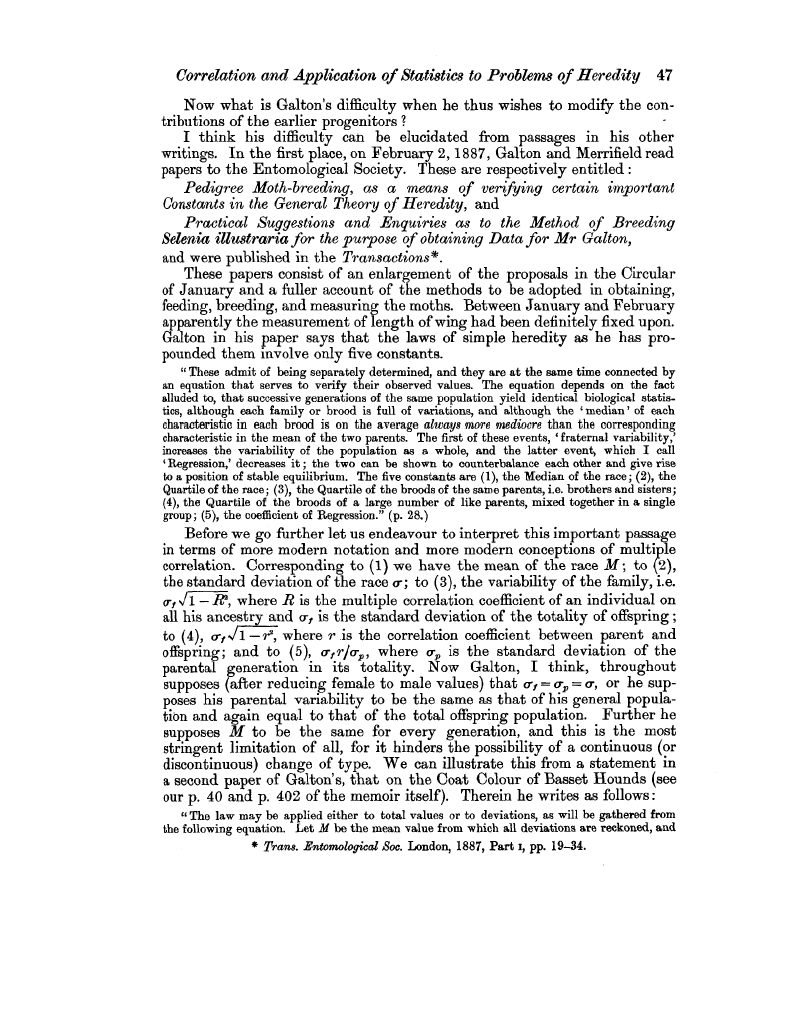| ||||||

OCR Rendition - approximate
Correlation and Application of Statistics to Problems of Heredity 47 Now what is Galton's difficulty when he thus wishes to modify the contributions of the earlier progenitors ? I think his difficulty can be elucidated from passages in his other writings. In the first place, on February 2, 1887, Galton and Merrifield read papers to the Entomological Society. These are respectively entitled Pedigree Moth-breeding, as a means of verifying certain important Constants in the General Theory of Heredity, and Practical Suggestions and Enquiries as to the Method of Breeding Selenia illustraria for the purpose of obtaining Data for Mr Galton, and were published in the Transactions*. These papers consist of an enlargement of the proposals in the Circular of January and a fuller account of the methods to be adopted in obtaining, feeding, breeding, and measuring the moths. Between January and February apparently the measurement of length of wing had been definitely fixed upon. Galton in his paper says that the laws of simple heredity as he has propounded them involve only five constants. "These admit of being separately determined, and they are at the same time connected by an equation that serves to verify their observed values. The equation depends on the fact alluded to, that successive generations of the same population yield identical biological statis tics, although each family or brood is full of variations, and although the `median' of each characteristic in each brood is on the average always more mediocre than the corresponding characteristic in the mean of the two parents. The first of these events, `fraternal variability,' increases the variability of the population as a whole, and the latter event, which I call ' Regression,' decreases it ; the two can be shown to counterbalance each other and give rise to a position of stable equilibrium. The five constants are (1), the Median of the race; (2), the Quartile of the race; (3), the Quartile of the broods of the same parents, i.e. brothers and sisters; (4), the Quartile of the broods of a large number of like parents, mixed together in a single group; (5), the coefficient of Regression." (p. 28.) Before we go further let us endeavour to interpret this important passage in terms of more modern notation and more modern conceptions of multiple correlation. Corresponding to (1) we have the mean of the race M ; to (2), the standard deviation of the race a-; to (3), the variability of the family, i.e. pa-f J1 - Ra, where R is the multiple correlation coefficient of an individual on all his ancestry and of is the standard deviation of the totality of offspring ; to (4), af./1 -r', where r is the correlation coefficient between parent and offspring; and to (5), o-,,r/o-p, where o, is the standard deviation of the arental generation in its totality. Now Galton, I think, throughout supposes after reducing female to male values) that o-f = ap = a-, or he supposes his parental variability to be the same as that of his general population and again equal to that of the total offspring population. Further he supposes M to be the same for every generation, and this is the most stringent limitation of all, for it hinders the possibility of a continuous (or discontinuous) change of type. We can illustrate this from a statement in a second paper of Galton's, that on the Coat Colour of Basset Hounds (see our p. 40 and p. 402 of the memoir itself). Therein he writes as follows: "The law may be applied either to total values or to deviations, as will be gathered from the following equation. Let M be the mean value from which all deviations are reckoned, and * Trans. Entomological Soc. London, 1887, Part i, pp. 19-34.
|